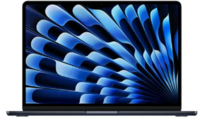Your new Macbook Air
About this article
This article highlights major changes and new features introduced by the latest laptop and tablet models offered through the E-Warrior Digital Life and Learning Program. It is intended for employees who are scheduled to exchange their laptops.
The Apple MacBook Air
Apple M3 Chip
Apple claims that this chip is the fastest it created to this date. That should translate into faster processing on large programs, cooler running temperatures, and quicker response times for all your computing needs.
Touch Bar and Touch ID
The Touch Bar and Touch ID are designed to provide contextual function keys that change with every application and tab you have open. The Touch Bar will allow software designers update functionality that is added as the program is updated. Below is a great introduction to the Touch Bar.
macOS Sonoma
This operating system includes a number of new features and functions and will be pre-installed on your new MacBook Air. If this is your first Mac laptop, you may want to consider spending some time familiarizing yourself with the macOS operating system.
Thunderbolt port
Beginning in summer 2011, Apple started replacing the Mini DisplayPort port with a new Thunderbolt port. The port has the same shape as the Mini DisplayPort and accommodates any Mini DisplayPort adapter you may have purchased previously. For example, if you have a Mini DisplayPort to VGA adapter that you use to connect your current MacBook to a projector, this will work with your new MacBook Air. The benefits of Thunderbolt include an increased data transfer rate (10 Gb/sec) and the ability to connect high-resolution displays and high-performance data devices through a single port. For more information, consult Apple's Thunderbolt FAQ article. Note: employees interested in this adapter should contact the Technical Support Center (TechSupport@winona.edu, 507-457-5240, Somsen Hall 207).
Frequently asked questions
Why do you have to configure my laptop? Where are all my software applications? Where can I get help? If you have questions, check our Frequently Asked Questions article for answers.
Set up and get to know your MacBook
After your laptop distribution session, you will need to make a few configurations to make it work functionally.
Everyone - Adding software
The following items cover what software is pre-loaded on your laptop and how to find additional software you may wish to use as a part of the E-Warrior Digital Life and Learning Program.
Pre-loaded software on the MacBook Air. You can check this list before loading any new software to the laptop.
Installing software from the network. Many unique or discipline specific software applications can be installed on your laptop (e.g. Adobe Acrobat XI Pro, Inspiration, Maple, Mathmatica, SPSS).
Installing software from the Mac OS X App Store. Programs such as iPhoto, iMovie, and Garageband are now optional applications that users can load based on their need and this article explains the process of installing these apps from the Apple App Store.
Everyone - File Storage
The MacBook Air has a 256 GB hard drive. Since hard drives crash and can get viruses, it is best practice to only store data there that you can do without if your system crashes. The use of network and cloud storage is recommended because it is backed up nightly.
OneDrive is a cloud-based storage for employees and students.
Local network storage refers to space, on networked servers located on the Winona campus and administered by WSU staff, reserved for employees to use to store their files. WSU maintains several servers intended for the local storage of employee files. These include network drives, OneDrive for Business, Web Storage and Class Storage.
Optional - Finding a printer
Faculty and Staff on Mac laptops now use the FollowMePrint client to connect to networked printers.
Optional - Digital Security
Addressing security threats and managing risk is a vital part of our eWarrior program and extensive documentation can be found here to educate yourself on the many measures that can be taken to prevent data breaches or spread of harmful viruses and malware.
Data Security. This link takes you to our article on governing laws and policies that relate to data.
What is Private Data? This article provides a quick summary of private data and how employees should protect this information.
What is Malware? This article on malware is intended to provide answers to this question and ways for you to prevent it from infecting your laptop.
What is Phishing? Another important topic to read up on so you can prevent your data from becoming exposed by phishing.
Locking your laptop screen is one security measure everyone is guilty of forgetting to do.
Multi-factor authentication for Office 365
Optional - Trackpad settings
The Mac trackpad has many gestures set up to use with it. The video below provides an overview of these gestures. You can also go to Settings and select the Trackpad icon to change the default settings. Matt Elliott provides an excellent introduction to the MacBook Force Touch trackpad in this CNET video How the Force Touch trackpad works.
Unsupported applications
If you installed any unsupported software for school or personal use such as a password vault, a citation manager (e.g., EndNote, Reference Manager), a tax preparation tool (e.g., TurboTax), or photo gallery software, back up any related files you wish to retain. Consult your documentation to determine the location and format of these files. TLT (tlt@winona.edu) will provide limited support if you have questions, but your first line of support is the vendor.
Related articles
- Review the hardware features of your new Apple MacBook Air
- Receiving your laptop
- Restoring your Mac laptop
LinkedIn Learning
Need help with software, try LinkedIn Learning online tutorials. With a LinkedIn Learning account, you will have access to over 2000 videos. Learn how to create your account profile by going to LinkedIn Learning for instructions.
